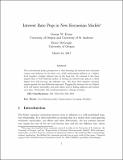Files in this item
Interest rate pegs in New Keynesian models
Item metadata
| dc.contributor.author | Evans, George W. | |
| dc.contributor.author | McGough, Bruce | |
| dc.date.accessioned | 2020-07-07T23:33:47Z | |
| dc.date.available | 2020-07-07T23:33:47Z | |
| dc.date.issued | 2018-08 | |
| dc.identifier | 249730758 | |
| dc.identifier | d91ea14f-51b5-44e5-ae16-db270b51e384 | |
| dc.identifier | 85050200817 | |
| dc.identifier | 000439803400004 | |
| dc.identifier.citation | Evans , G W & McGough , B 2018 , ' Interest rate pegs in New Keynesian models ' , Journal of Money, Credit and Banking , vol. 50 , no. 5 , pp. 939-965 . https://doi.org/10.1111/jmcb.12523 | en |
| dc.identifier.issn | 0022-2879 | |
| dc.identifier.uri | https://hdl.handle.net/10023/20215 | |
| dc.description | Financial support from National Science Foundation Grant No. SES-1559209 is gratefully acknowledged. | en |
| dc.description.abstract | The conventional policy perspective is that lowering the interest rate increases output and inflation in the short run, while maintaining inflation at a higher level requires a higher interest rate in the long run. In contrast, it has been argued that a Neo‐Fisherian policy of setting an interest‐rate peg at a fixed higher level will increase the inflation rate. We show that adaptive learning argues against the Neo‐Fisherian approach. Pegging the interest rate at a higher level will induce instability and most likely lead to falling inflation and output over time. Eventually, this would precipitate a change of policy. | |
| dc.format.extent | 570405 | |
| dc.language.iso | eng | |
| dc.relation.ispartof | Journal of Money, Credit and Banking | en |
| dc.subject | Neo-Fisherian policy | en |
| dc.subject | Expectations | en |
| dc.subject | Learning | en |
| dc.subject | Stability | en |
| dc.subject | HB Economic Theory | en |
| dc.subject | HG Finance | en |
| dc.subject | NDAS | en |
| dc.subject | BDC | en |
| dc.subject | R2C | en |
| dc.subject.lcc | HB | en |
| dc.subject.lcc | HG | en |
| dc.title | Interest rate pegs in New Keynesian models | en |
| dc.type | Journal article | en |
| dc.contributor.institution | University of St Andrews. School of Economics and Finance | en |
| dc.identifier.doi | https://doi.org/10.1111/jmcb.12523 | |
| dc.description.status | Peer reviewed | en |
| dc.date.embargoedUntil | 2020-07-08 |
This item appears in the following Collection(s)
Items in the St Andrews Research Repository are protected by copyright, with all rights reserved, unless otherwise indicated.

